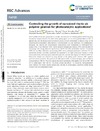Identificador persistente para citar o vincular este elemento:
https://accedacris.ulpgc.es/jspui/handle/10553/73080
| Título: | Controlling the growth of nanosized titaniaviapolymer gelation for photocatalytic applications | Autores/as: | El Jemli, Yousra Mansori, Mohammed González Díaz, Oscar Manuel Barakat, Abdellatif Solhy, Abderrahim Abdelouahdi, Karima |
Clasificación UNESCO: | 221001 Catálisis | Fecha de publicación: | 2020 | Publicación seriada: | RSC Advances | Resumen: | Nanocrystalline titania was synthesized by a simple, innovative and eco-friendly gelation method by using biopolymers (polysaccharides). The effect of the gelling agent, such as carboxymethylcellulose (CMC) or alginate (Alg), and the drying routes (conventional drying at room temperature, or freeze-drying) on the properties and photocatalytic performances of nanostructured TiO2was examined. The crystallographic structures, and textural and morphological characteristics were investigated by thermogravimetric analysis (TGA), X-ray diffraction (XRD), Fourier transform infrared spectroscopy (FTIR), scanning electron microscopy with energy dispersive spectrometry (ESEM-FEG-EDS), transmission electron microscopy (TEM), UV-vis diffuse reflectance spectroscopy (DRS) and N2adsorption/desorption isotherms. The as-synthesized samples were fully crystallized and appeared to be highly phase-pure anatase or mixed titania polymorphs, and have a quasi-spherical shape with a particle size ranging from 10.34 to 18.07 nm. Phase-pure anatase was obtained by using alginate as the gelling agent, whereas CMC's gelation promotes mixed structures. The presence of rutile phase results in a lower bandgap value of 3.04 eV corresponding to 408 nm. Thus, the material absorption wavelength shifts slightly from the UV (190-380 nm) to visible region (380-750 nm). The drying process also affects TiO2properties. The lyophilization route improves the oxide's specific surface area, and also its photocatalytic properties verified during Orange G dye photodegradation study. | URI: | https://accedacris.ulpgc.es/handle/10553/73080 | ISSN: | 2046-2069 | DOI: | 10.1039/d0ra03312j | Fuente: | RSC Advances [EISSN 2046-2069], v. 10 (33), p. 19443-19453, (Mayo 2020) |
| Colección: | Artículos |
Citas SCOPUSTM
7
actualizado el 08-jun-2025
Citas de WEB OF SCIENCETM
Citations
6
actualizado el 08-jun-2025
Visitas
171
actualizado el 12-jul-2025
Descargas
170
actualizado el 12-jul-2025
Google ScholarTM
Verifica
Altmetric
Comparte
Exporta metadatos
Los elementos en ULPGC accedaCRIS están protegidos por derechos de autor con todos los derechos reservados, a menos que se indique lo contrario.
